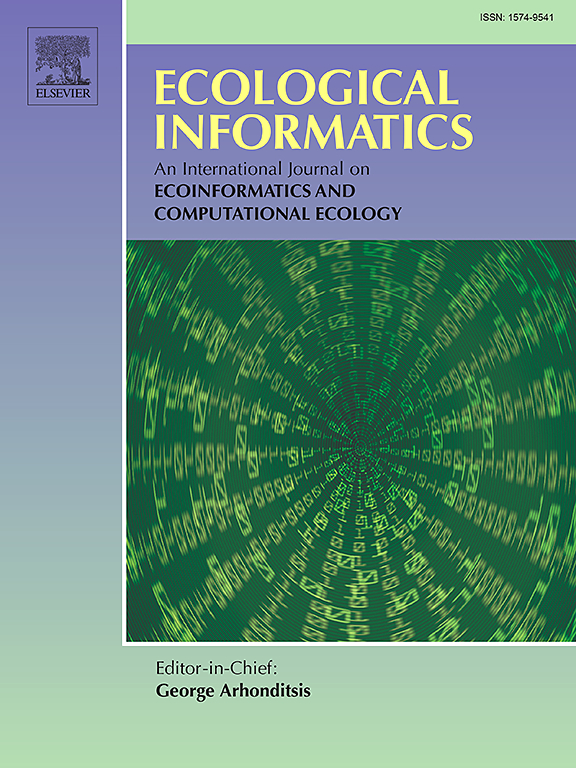Dynamic mapping of dissolved oxygen in freshwater aquaculture ponds using UAV multispectral imagery
IF 7.3
2区 环境科学与生态学
Q1 ECOLOGY
引用次数: 0
Abstract
Dissolved oxygen (DO) is an important indicator of the water health of the freshwater aquaculture pond. However, since DO is a non-photosensitive parameter, it is difficult to directly inverse using UAV imaging technology. We proposed an estimation method of DO based on UAV multispectral data and machine learning algorithms. The method utilizes chlorophyll-a (Chl-a) and spectral indices as input features to accurately estimate DO content in water bodies. UAV images were collected in six periods at two aquaculture ponds. Machine learning algorithms were applied to map Chl-a concentration in each aquaculture pond, and a DO estimation model was developed through the relationship between Chl-a, spectral index and DO. The model was validated using measured samples, and the spatial and temporal variations in DO at the two freshwater aquaculture ponds were analyzed. The findings demonstrated that the model exhibited suboptimal performance when solely utilising spectral index. However, the incorporation of Chl-a as an input feature resulted in a substantial enhancement in model performance, in comparison to the utilisation of only spectral index. The RF model performed well during both training and testing phases at the first freshwater aquaculture pond, achieving R2 = 0.87, RMSE = 1.785 mg/L, and MAE = 1.512 mg/L for the testing set. Concurrently, the validation in the other two periods(GC - August and October 2023 and PK-April and May 2024) further confirmed the model's generalization ability, with R2 = 0.84, RMSE = 2.245 mg/L, and MAE = 1.251 mg/L. Similarly, the model showed robust performance at the second freshwater aquaculture pond, achieving R2 = 0.85, RMSE = 3.743 mg/L, and MAE = 2.730 mg/L. UAV multispectral imaging technology combined with this method can efficiently and accurately capture the spatial and temporal distribution of DO in freshwater aquaculture pond, supporting aquaculture management.
基于无人机多光谱影像的淡水养殖池塘溶解氧动态制图
溶解氧(DO)是淡水养殖池塘水体健康的重要指标。然而,由于DO是一个非光敏参数,使用无人机成像技术很难直接反演。提出了一种基于无人机多光谱数据和机器学习算法的DO估计方法。该方法利用叶绿素a (Chl-a)和光谱指数作为输入特征,准确估算水体中DO的含量。在2个养殖场分6期采集无人机影像。利用机器学习算法绘制各养殖池的Chl-a浓度图,并通过Chl-a、光谱指数与DO的关系建立DO估计模型。利用实测样本对模型进行了验证,并分析了两个淡水养殖池塘DO的时空变化特征。结果表明,当仅利用光谱指数时,该模型表现出次优的性能。然而,与仅使用光谱指数相比,将Chl-a作为输入特征的结合大大提高了模型性能。RF模型在第一个淡水养殖塘的训练和测试阶段均表现良好,测试集的R2 = 0.87, RMSE = 1.785 mg/L, MAE = 1.512 mg/L。同时,另外两个时期(GC - 2023年8月、10月和pk - 2024年4月、5月)的验证进一步证实了模型的泛化能力,R2 = 0.84, RMSE = 2.245 mg/L, MAE = 1.251 mg/L。同样,该模型在第二淡水养殖塘也表现出稳健的性能,R2 = 0.85, RMSE = 3.743 mg/L, MAE = 2.730 mg/L。无人机多光谱成像技术与该方法相结合,可以高效、准确地捕获淡水养殖池塘DO的时空分布,为养殖管理提供支持。
本文章由计算机程序翻译,如有差异,请以英文原文为准。
求助全文
约1分钟内获得全文
求助全文
来源期刊

Ecological Informatics
环境科学-生态学
CiteScore
8.30
自引率
11.80%
发文量
346
审稿时长
46 days
期刊介绍:
The journal Ecological Informatics is devoted to the publication of high quality, peer-reviewed articles on all aspects of computational ecology, data science and biogeography. The scope of the journal takes into account the data-intensive nature of ecology, the growing capacity of information technology to access, harness and leverage complex data as well as the critical need for informing sustainable management in view of global environmental and climate change.
The nature of the journal is interdisciplinary at the crossover between ecology and informatics. It focuses on novel concepts and techniques for image- and genome-based monitoring and interpretation, sensor- and multimedia-based data acquisition, internet-based data archiving and sharing, data assimilation, modelling and prediction of ecological data.
 求助内容:
求助内容: 应助结果提醒方式:
应助结果提醒方式:


